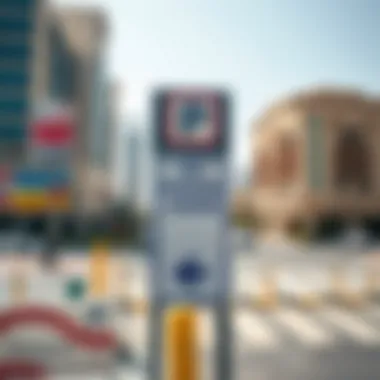Understanding Dubai's Pay Parking System: A Guide


Intro
Navigating the bustling streets of Dubai can often feel like steering through a sea of concrete and chrome. For both residents and visitors, one of the more daunting tasks involves finding appropriate parking spots. The pay parking system in Dubai has transformed this experience, implementing a structured arrangement designed to facilitate urban mobility. In this guide, we delve into the intricacies of Dubai's pay parking landscape, examining its operational framework, technological advancements, and the myriad ways it influences both drivers and the broader urban environment.
The relevance of understanding pay parking in Dubai goes beyond avoiding fines or finding a parking space; it reflects a larger conversation about urban planning and the necessity of balancing convenience with regulation. As the city burgeons with investments and an influx of residents, the parking system has become a focal point of discussion among investors and homeowners alike. This guide seeks not just to inform but to empower readers—be it investors looking toward real estate opportunities or locals seeking insights into the evolving parking dynamics.
Through this exploration, we aim to illuminate the connections between the pay parking system, the diverse dynamics of urban life, and the implications for all stakeholders. As Dubai continues to pave its way forward, understanding its parking framework becomes vital for anyone trying to carve out their niche in this vibrant metropolis.
Foreword to Pay Parking in Dubai
Understanding the pay parking system in Dubai is essential for anyone involved in urban mobility, whether it’s a local commuter, a visitor, or an investor surveying the real estate landscape. As one of the fastest-growing cities in the world, Dubai has implemented a parking system that reflects its ambition and modernization. The insights gained from exploring this system can shape perceptions about accessibility, sustainable urban development, and individual responsibility towards public resource usage.
The Evolution of Parking Solutions
The development of parking solutions in Dubai has transformed remarkably over recent years. Initially, parking spaces in Dubai were scarce, leading to congestion and frustrating experiences for drivers. To tackle these challenges, the government gradually introduced pay parking zones, starting as early as the mid-2000s. The aim was not just to generate revenue, but to enhance the efficiency of the parking system.
As the city expanded, parking technology evolved alongside it. Innovations such as automated parking meters and digital payment systems emerged, which helped streamline the process for users.
Now, parking areas are extensively regulated, with designated zones across various districts, each equipped with different payment models tailored to their unique needs. The approach has shifted from reactive to proactive, instigating more structured planning while looking forward to future advancements.
Purpose and Benefits of Pay Parking
The introduction of pay parking is much more than a financial endeavor. Here are several key benefits that epitomize its role in urban life in Dubai:
- Financial Revenue: The fees collected from pay parking contribute directly to local government initiatives, including infrastructure development and maintenance. This creates a sustainable funding model that can be reused to enhance community facilities.
- Reducing Traffic Congestion: By implementing paid parking systems, the city encourages drivers to consider alternatives such as public transport or shared vehicles. This ultimately reduces the volume of cars circling for spaces, thereby decreasing congestion.
- Fair Allocation of Resources: Pay parking ensures that those who utilize the parking facilities bear the costs associated with maintenance and provision. Without this model, parking spaces could be monopolized by a few, making it harder for others to find a spot.
- Enhanced Urban Planning: The data collected through parking usage patterns ultimately helps city planners understand how spaces are utilized. This information is invaluable for future developments and expansions, ensuring they remain ahead of demand.
"The shift towards paid parking is a crucial part of an ongoing strategy to not just meet the needs of today, but to preemptively address the challenges of tomorrow's urban landscape."
Overview of the Pay Parking System
The pay parking system in Dubai is a crucial component of the urban transport framework, designed to manage and regulate vehicle parking efficiently. Understanding the structure and rationale behind this system can aid motorists, residents, and stakeholders alike in navigating the complexities of parking in one of the fastest-growing cities in the world.
Types of Pay Parking Areas
One of the primary facets of the pay parking setup is the distinction between types of parking areas available to users. Each type offers unique advantages, aimed at accommodating the diverse needs of drivers in various locations throughout the city.
On-street Parking
On-street parking is readily available along city streets, providing immediate access to nearby businesses and residential areas. Its key characteristic is convenience. Drivers can easily park right by their destination, minimizing their walking distance. This form of parking is particularly popular in busy districts where finding a spot can be a matter of urgency.
However, on-street parking also comes with its disadvantages. The unique feature of this type is that it often has time restrictions, meaning vehicles cannot remain parked indefinitely. This regulation prevents monopolization of parking spots but can lead to frustration when a driver has to move their vehicle frequently. Additionally, the pricing can vary based on the neighborhood, which can further complicate planning for those who rely heavily on these spaces.
Off-street Parking
Contrastingly, off-street parking tends to be located in dedicated lots or garages, providing a more secure and spacious alternative. The key characteristic of off-street parking is its capacity. These lots often accommodate significantly more cars than on-street areas, making them less prone to overcrowding, especially during peak times.
However, the increased distance from the immediate area can be a drawback, as these lots require a bit of extra walking. Another unique feature is that off-street parking often tends to be pricier than on-street options. This can influence drivers’ choices, especially those mindful of budget constraints. Overall, it serves as a solid option for those who can afford it and seek reliability in finding a parking spot.
Residential Areas


Pay parking in residential areas is a controversial yet essential aspect of Dubai's parking landscape. Typically aimed at regulating long-term parking for residents and their visitors, this type affects many residents directly. Its key characteristic is the implementation of designated parking slots in predominantly residential zones. The convenience is manifold, particularly for those living in densely populated areas.
One unique feature of residential pay parking is its tendency to favor residents by providing permits or allocating specific zones only for local users. This system aims to ensure that residents can access parking while limiting the overcrowding of nearby streets by non-residents. However, disadvantages can arise when it comes to enforcement, as many residents might face challenges in finding available space due to visitor overflow, resulting in mixed opinions about its effectiveness.
Pay Parking Rates and Timings
Understanding the rates and timings associated with each type of parking is vital for planning. Each parking area operates under specific time restrictions and tariff structures, which can greatly influence the decision of where to park. Systematic variations exist depending on the location, time of day, and type of parking spot.
Monitoring these elements can significantly enhance the utility of the pay parking system, ensuring that users make informed choices that align with their schedules and budget constraints. With the rapid growth of Dubai and the increasing influx of both residents and tourists, a solid understanding of these regulations and structures will prove beneficial.
"Navigating Dubai's pay parking landscape requires awareness not just of where to park but also of the associated costs and restrictions that come with each choice."
By diving into the intricacies of an organized pay parking system, all stakeholders from investors to daily commuters can grasp the full picture of how parking operates within the vibrant tapestry of urban life in Dubai.
Parking Meters and Payment Methods
The landscape of parking in bustling cities like Dubai is constantly evolving. As urban areas grapple with congestion and limited space, effective payment systems become indispensable. Understanding the different parking meters and payment methods is key for motorists navigating this concrete jungle. Not only do these systems streamline the parking process, they also influence urban mobility and ease of access.
Types of Parking Meters
Coin-operated Meters
Coin-operated meters have been around long enough to be considered a staple in parking systems worldwide. These meters do one thing simply: they take cash and provide a receipt for a parking space. One key characteristic of coin-operated meters is their accessibility. Drivers may find comfort in this form of payment, knowing that they can pay directly without relying on technology.
Among the compelling aspects of coin-operated meters is their robustness. They don't depend on internet connectivity or batteries, meaning they can remain functional in various conditions. However, the downside might be the potential for users to realize they don’t have the right change, which can lead to frustrations. This traditional method remains a reliable choice, especially for certain populations who might not be tech-savvy.
Digital Payment Systems
On the other end of the spectrum are digital payment systems. These smart meters represent a leap forward in how people manage parking payments. They often come with a touchscreen interface, allowing users to input their vehicle's information and pay via credit or debit card. The most attractive feature of digital payment systems is their convenience. Drivers can swiftly complete transactions, which reduces the time spent looking for change.
Moreover, digital meters can be programmed to update rates or have the capability to alert motorists when their time is about to expire—a feature that keeps drivers in the know. However, reliance on technology also has its pitfalls. Issues such as outages or user error could leave motorists struggling. Yet, for the majority, these modern systems are an efficient way to navigate urban parking.
Mobile Payment Apps
Building on the advancements of digital payment systems, mobile payment applications are paving the way for a new era in parking management. These apps allow drivers to pay for parking directly from their smartphones, streamlining the entire process into a few taps.
Features of Mobile Apps
Mobile payment apps typically showcase a range of features that cater to the needs of users. Not only can motorists find available parking spots, but they can also reserve spaces, extend their parking duration, and even review parking history all within the app. A significant strength of these apps is real-time updates, which provide users with crucial information such as whether a space is available or if fees have changed. These innovations enhance the parking experience and make it simple and user-friendly.
However, challenges do exist. Different app requirements or a lack of compatible devices can create barriers for some users. While they represent the cutting edge of convenience, ensuring that everyone can access this technology is essential for equitable service.
Security Considerations
As convenient as they are, mobile payment apps bring an array of security considerations that can’t be brushed aside. Users need to be aware of how their data is protected when utilizing these apps. Common features include biometric authentication and encryption protocols, safeguarding users against potential breaches.
However, the reliance on smartphones does add a layer of vulnerability. A misplaced phone or unsecured Wi-Fi connection can open the door to unauthorized access. While these apps may provide unparalleled convenience, potential security risks are a noteworthy downside that users must consider seriously.
Regulations Surrounding Pay Parking


The framework of regulations governing pay parking in Dubai isn’t merely a bureaucratic necessity; it serves as the backbone for a structured and efficient urban mobility system. These regulations are designed to manage space effectively, ensuring that every street corner, lot, and parking structure contributes positively to the community. A fair system not only increases revenue for municipal projects but also creates an environment that encourages responsible driving behavior and compliance among motorists. It's essential for investors, homeowners, and anyone involved in real estate in Dubai to grasp how these rules shape their strategies and decisions.
Government Policies and Management
The government of Dubai has implemented a series of policies that are pivotal to the management of pay parking. The aim isn't just about charging drivers for parking but rather optimizing the available space and reducing traffic congestion, which is often a significant concern in rapidly developing urban areas like Dubai. Local authorities have established standards that set guidelines for the operational hours of pay parking, pricing structures, and even how to allocate spaces for residents versus short-term visitors.
Consider, for instance, the Dubai Roads and Transport Authority (RTA), which oversees the parking systems. Their policies not only influence pricing but also how parking facilities are integrated into the broader urban infrastructure, such as the availability of pedestrian pathways and public transport links. The RTA operates under a strategic framework to enhance the user experience while simultaneously encouraging the use of public transport, thereby reducing the reliance on personal vehicles.
These policies can have direct financial implications, which is important for investors to take note of. For example, areas designated for commercial activity might feature different pay rates compared to residential zones, which could affect leasing decisions and land value assessments.
Rights and Responsibilities of Motorists
Motorists in Dubai are afforded specific rights and responsibilities concerning pay parking. Recognizing these rights is crucial for users to navigate the system without unnecessary hassle. For instance, drivers have the right to expect clear, visible signage that indicates parking regulations, payment methods, and available spaces. However, the flip side of the coin is that they must comply with the established rules, such as paying fees promptly and adhering to parking durations to avoid fines.
A significant responsibility for motorists is to stay updated on payment methods, which can range from using parking meters to mobile apps. Each method has its own user guidelines, and failing to comply can lead to penalties. Additionally, understanding the implications of parking violations is key for motorists, as fines can escalate quickly and affect driving records.
Impact on Urban Mobility and Environment
Understanding the interplay between pay parking systems and urban mobility is critical, especially in a rapidly evolving city like Dubai. Effective parking solutions can greatly influence traffic conditions, determine the accessibility of neighborhoods, and shape the interaction between residents and their environment. Dubai has grown tremendously, and as a result, the demand for efficient parking management has become a necessity rather than merely an option. Significant implications for both motorists and real estate investors warrant deep exploration.
Traffic Flow and Congestion Management
When we talk about traffic flow, it’s about the smooth movement of vehicles throughout the city. Pay parking systems, if optimally administered, can significantly contribute to reducing congestion. Here's how:
- Strategic Placement: Parking areas are often strategically placed to ensure proximity to business districts and tourist spots, easing the pressure of traffic in those regions.
- Encouraging Space Turnover: Pay parking encourages drivers to use available spaces more efficiently, as there’s an inherent economic incentive to move vehicles after a designated period of time. This turnover helps ensure that parking spaces are utilized without allowing long-term blockage of access.
- Reduction of Illegal Parking: By making parking spaces available for a fee, the system reduces illegal parking and subsequently frees up roadways as drivers no longer hunt for open spots, which can cause overwhelming congestion.
"An efficient parking management strategy can turn a congested area into a smoothly flowing traffic corridor, benefitting both drivers and local businesses."
Sustainability and Environmental Considerations
The implications of pay parking on sustainability cannot be overstated. In many ways, the parking structure serves as a microcosm for broader environmental concerns:
- Fewer Emissions: With a well-structured pay parking system, the time spent searching for parking is minimized, which directly translates to lower vehicular emissions. Less idling on roadways contributes to better air quality.
- Promoting Alternative Transportation: Higher parking costs can deter some vehicle use, nudging people to consider other modes of transport such as public transit, cycling, or walking. This shift helps reduce traffic volume and enhances the overall urban experience.
- Green Initiatives: Cities around the world are introducing green parking initiatives, like solar-powered meters or spaces designated for electric vehicles. Dubai, striving to position itself as a sustainable city, could harness the pay parking framework to promote such environmentally-friendly practices.
Overall, the impact of pay parking on urban mobility and environmental health is intricate yet vital. For investors, understanding these dynamics can provide relevant insights into how the parking infrastructure influences property values and development potential in various Dubai locales. As the city continues to expand, the interrelationship between pay parking, traffic management, and sustainability will play a pivotal role in shaping its urban landscape.
Challenges and Critiques of the System
The topic of pay parking in Dubai is not without its challenges and critiques. As with any urban system, the pay parking framework faces scrutiny from drivers, residents, and stakeholders alike. Exploring these challenges is essential, not only to understand the shortcomings of the existing system but also to ensure future developments are more effective and accommodating. This section sheds light on common issues faced by drivers, such as overcharging and accessibility concerns, and provides constructive suggestions for improvement.
Common Issues Faced by Drivers
Overcharging and Fines
One key issue that plagues many drivers in Dubai is the potential for overcharging and fines. In a busy city like Dubai, motorists can often find themselves caught in a web of confusion regarding parking fees. Higher-than-expected charges can arise from misinterpretation of the parking meter rules or operational oversights, leading to unnecessary expenses.
The strict fine system employed in this city can at times feel punitive. For example, when a driver forgets to pay the fee or accidentally overstays their allotted time, the fines can quickly add up, creating frustration. This scenario not only impacts the driver's wallet but also their experience in using the pay parking system altogether. It’s clear that the risk of miscommunication can be a double-edged sword, making it a bitter pill for many in Dubai’s bustling environment.
Accessibility Concerns


Accessibility is another significant concern in the pay parking landscape. While Dubai has made substantial strides in enhancing accessibility across urban infrastructure, the pay parking system sometimes falls short, primarily affecting those with disabilities or special needs. In some areas, limited access to handicap parking spots or poorly marked spaces can complicate the urban experience for those who require additional support.
Moreover, the inconsistent availability of accessible parking can deter many from visiting key urban centers, thus limiting their mobility and overall engagement with the city. These challenges emphasize a need for ongoing assessment and adaptation in parking policies to ensure all residents and visitors can navigate Dubai with ease. Understanding these issues paints a clearer picture of the current parking landscape.
Suggestions for Improvement
While it’s easy to highlight the critiques of the pay parking system, it’s equally important to offer constructive Suggestions for Improvement. Here are several strategies that stakeholders could consider:
- Implement clearer signage to help drivers understand fees and rules related to parking.
- Introduce an appeal process for contested fines, allowing drivers to be heard regarding their grievances.
- Increase the number of accessible parking spaces and ensure they are strategically placed near entry points of popular destinations.
- Develop an informative outreach program to educate drivers about the digital payment options available, helping them navigate the system more effectively.
- Encourage the integration of real-time data on available parking spots through mobile applications, aiding in efficient parking searches.
With these avenues for improvement, there exists the potential not only to enhance the parking experience for drivers but also to bolster the image of Dubai as a modern, friendly city that values its residents and visitors alike.
Future Trends in Pay Parking
The pay parking landscape in Dubai is not static; it is continuously evolving to meet the needs of its residents and the dynamics of urban life. As Dubai stays on the cutting edge of innovation, the future of pay parking denotes a broader trend—one that intersects technology, urban design, and environmental sustainability. This section will serve as a guide for stakeholders, including investors, homeowners, and urban planners, on the immediate and long-term implications of future trends in the parking sector.
Technological Innovations
AI and Smart Parking Solutions
The rise of smart parking solutions has been revolutionary. Advanced algorithms and artificial intelligence play a pivotal role in optimizing parking resources. These systems not only allow drivers to locate available spaces via mobile apps but can also analyze parking patterns, adjusting rates dynamically based on demand.
A key characteristic of AI in smart parking is its data-processing capability. It efficiently monitors parking meters, encouraging compliance through timely notifications via apps. A unique feature is the potential for predictive analytics that can foresee peak hours, allowing motorists to schedule their parking needs accordingly. However, while these systems enhance convenience, the initial investment in infrastructure can be intimidating for some municipalities. Nonetheless, the long-term benefits often outweigh these challenges.
Integration with Urban Planning
Integrating pay parking solutions with urban planning is becoming a standard practice. This approach considers the holistic nature of city life, focusing on enhancing accessibility while promoting public transportation. The key characteristic of this integration is its focus on multi-modal transport systems. It marries parking strategy with public transport routes, effectively reducing congestion and enhancing convenience for users.
A unique feature of this integration is its potential to create pedestrian-friendly zones. By limiting on-street parking in certain areas, planners can give priority to walking and cycling. However, a drawback might manifest in pushback from drivers accustomed to easy parking access. Balancing the needs of motorists and city planners isn’t simple but promises a cleaner, more organized urban environment if done correctly.
The Role of Public Transport in Parking Management
Public transport has a significant role in managing pay parking. Efficient public transport options encourage residents and visitors to park further from their destination and utilize buses or metro systems. This shift not only alleviates congestion in busy areas but also minimizes the reliance on personal vehicles, fostering a culture of shared transit. Investors should consider developments near public transport hubs; properties in these locations often command higher value due to their appealing convenience.
In short, understanding the future trends in pay parking—specifically the intertwining of technology and urban planning—provides invaluable insights for various stakeholders. It offers a glimpse into how these shifts can enhance urban living and drive investment decisions, ultimately setting the stage for a more navigable and sustainable Dubai.
Closure
The conclusion of this article encapsulates the various facets of Dubai's pay parking system. This system is not just a means for generating revenue; it plays a fundamental role in urban planning, addressing parking challenges, and facilitating mobility. The nuanced understanding of its structure and operational mechanisms presents a clear picture of how urban environments can evolve through effective management strategies.
Summary of Key Insights
At the heart of the exploration lies a series of insights that merit consideration:
- Evolution and Purpose: Pay parking in Dubai has come a long way from rudimentary solutions to a sophisticated framework that serves multiple purposes, including traffic management and environmental sustainability.
- Regulations and Rights: Understanding government regulations aids drivers in navigating their rights and obligations, leading to a more responsible use of parking facilities.
- Technological Enhancements: Advances in parking technology, such as digital payment systems and mobile applications, reflect a broader trend of tech integration in everyday aspects of life, enhancing user experience.
- Environmental Impact: The pay parking system has implications on urban congestion and sustainability, making it a crucial element in Dubai’s commitment to environmental stewardship.
- Future Trends: Awareness of emerging trends in pay parking can help stakeholders adapt to changes in urban mobility dynamics.
These insights provide a robust foundation for understanding not only the operational features of the pay parking system but also its broader implications for urban development in Dubai.
Implications for Real Estate Investors
For real estate investors, the pay parking system in Dubai is a key consideration for several reasons:
- Market Viability: Understanding local parking regulations can influence the attractiveness of a property investment. Properties in areas with accessible parking solutions may see enhanced value and higher demand.
- Urban Planning: Investors should factor in the city’s overall urban plan, including the integration of pay parking with public transport. Projects that align with governmental transport initiatives can be more sustainable and lucrative.
- Potential Revenue Streams: Investing in properties that incorporate parking facilities can provide steady returns. Additionally, with the advent of technological advancements, properties featuring modern payment and management systems may command premium prices.
- Regulatory Compliance: Staying informed about regulatory changes enables investors to safeguard their investments against potential legal issues or changes in operational costs.
In sum, the implications of Dubai’s pay parking system extend well beyond the mechanics of parking itself. Keeping an eye on these elements will equip investors to make informed, strategic decisions that harness the vitality of the market while navigating its complexities.
In today's fast-paced environment, a keen understanding of urban infrastructure, such as pay parking, plays a pivotal role in shaping successful investment strategies.











